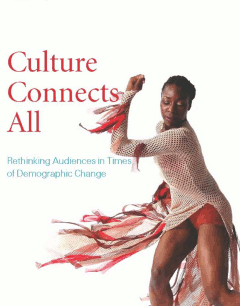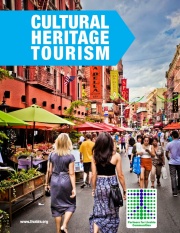Partners' Major Initaitives under the Culture Builds Communities Program
1. The Role of Culture in the New Livability Paradigm
For the past four decades, Partners has been working to define livability and incorporate the term into the civic lexicon. Today, livability has become a hallmark of the new administration and is consistently recognized in Congress as an important goal. Partners is working to broaden the scope of the livability conversation to include everything from culture to libraries to parks and recreational space to quality design. Partners is engaging federal agencies, Congressional representatives, think tanks and cultural institutions to explore and highlight how these amenities can be engaged as tools in four arenas of livability: the economic, social, built and natural environments.
2. Art, Culture and Neighborhood Change: The Shifting Sands Initiative
The Shifting Sands Initiative seeks to build common vision, create tolerance and respect, and boost economic prospects in rapidly changing underserved neighborhoods. To accomplish these goals, Partners and a group of national technical advisors worked with community-based arts organizations over a period of seven years to develop programs supporting social integration across race and class, upward economic mobility, neighborhood identity, civic engagement and community development. Download the Shifting Sands brochure.
3. Changing Demographics and What It Means for Arts and Culture Institutions
In the next two decades, the number of adults age 65+ in the U.S. will double to more than 70 million. This upward trend is also true of the immigrant population.
On January 1, 2011, the first of an estimated 78 million baby boomers turned 65, to be followed by 11,000 more each day for the next two decades. The older adult population will almost double by 2030, when one in every five Americans will be 65 and above (U.S. Government Printing Office, 2005). The immigrant population is increasing just as rapidly. Immigrants (those who are foreign-born) in the United States increased from 19.8 million to 37.9 million between 1990 and 2007, a trend projected to continue. Today, one in eight residents is foreign-born, and strategists predict that in 2050, there will be no single majority in the United States. Among the foreign-born population, 20% (6 million people) are 55 or older, with Asian and Hispanic elders comprising the fastest growing segment of this population.
Yet despite the tremendous demographic changes of the past 20 years, the audiences for arts and culture activities have not significantly increased or broadened. By providing outlets for creative expression and building bridges connecting different groups in their communities, Partners believes that arts and culture organizations can position themselves as critical community institutions and catalysts for positive community change. In the past years, Partners, with the support of MetLife Foundation, has been focusing on these phenomenal demographic changes by releasing two seminal reports to help arts and new audiences: Culture Connects All (2011) and Stories for Change (2012).
Arts and cultural organizations around the country are providing new opportunities to engage America’s fastest growing populations. The demographic wave poses new challenges for communities that must retool and rethink their plans: to provide new and different access to services, re-frame the model of a livable community, and in general adopt creative methods to meet the unique needs of immigrants and older adults.
 Culture Connects All, a 2011 report by Partners for Livable Communities and funded by MetLife Foundation, showcases arts and cultural organizations implementing groundbreaking programs and strategies to help address the demographic changes occurring across the country. The beginning of 2011 marked the emergence of America’s two fastest growing populations, older adult and immigrant populations.
Culture Connects All, a 2011 report by Partners for Livable Communities and funded by MetLife Foundation, showcases arts and cultural organizations implementing groundbreaking programs and strategies to help address the demographic changes occurring across the country. The beginning of 2011 marked the emergence of America’s two fastest growing populations, older adult and immigrant populations.
Culture Connects All describes the current status and future opportunities of the U.S. arts and culture sector, followed by in-depth examinations of two populations: immigrants and older adults (those aged 65 and over). The report describes some of the most salient aspects of these groups for cultural organizations, and how they can and already do engage with the cultural sector.
Partners for Livable Communities (Partners) researched and interviewed leaders of arts and cultural organizations in six cities: Atlanta, Chicago, Dallas, New York City, Phoenix and Tampa. Organizations were chosen for creating arts and cultural experiences that satisfy the interests and any specialized needs of their immigrant and older adult audiences.
Click here to read more about and to download Culture Connects All
Click download the translated version of Culture Connects All in Spanish and Simplified Chinese
 Stories for Change, a report by Partners for Livable Communities funded by MetLife Foundation, offers leadership examples that expand the arts to new audiences. This compendium of nearly 50 best practices showcases the notable strategies that increase access to arts and culture for older adult and immigrant populations. Stories for Change broadens the scope of Partners’ 2011 report, Culture Connects All.
Stories for Change, a report by Partners for Livable Communities funded by MetLife Foundation, offers leadership examples that expand the arts to new audiences. This compendium of nearly 50 best practices showcases the notable strategies that increase access to arts and culture for older adult and immigrant populations. Stories for Change broadens the scope of Partners’ 2011 report, Culture Connects All.
Stories for Change is a compelling collection, brimming with new ideas brought to fruition by many types of organizations including: museums, libraries, community development organizations, theaters, orchestras, dance ensembles, area agencies on aging, transportation bureaus, parks, botanic gardens, universities, and more. Organizations that hope to enhance the lives of their older and immigrant residents can find approaches portrayed in these Stories that can be adapted to meet the needs of their communities. Click here to read more about and download Stories for Change.
4. Cultural Heritage Tourism
 Partners for Livable Communities is one of the founders of the themes of cultural tourism, discovery tourism and heritage tourism. Partners views cultural heritage tourism as a means of providing economic and social benefits to communities through sustainable development and community empowerment. By using cultural assets to appeal to the cultural heritage tourist, communities can instill local pride and ensure a sustainable economic base. Click here to download Culture Heritage Tourism.
Partners for Livable Communities is one of the founders of the themes of cultural tourism, discovery tourism and heritage tourism. Partners views cultural heritage tourism as a means of providing economic and social benefits to communities through sustainable development and community empowerment. By using cultural assets to appeal to the cultural heritage tourist, communities can instill local pride and ensure a sustainable economic base. Click here to download Culture Heritage Tourism.
